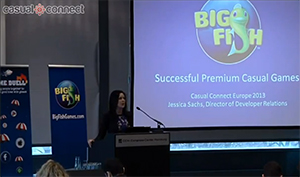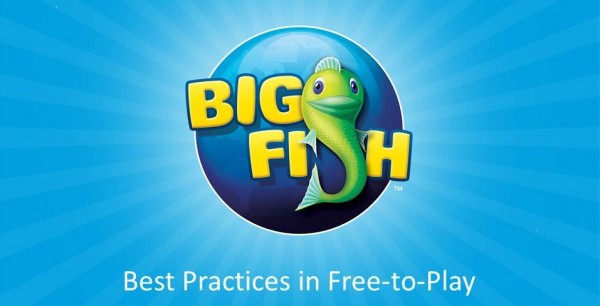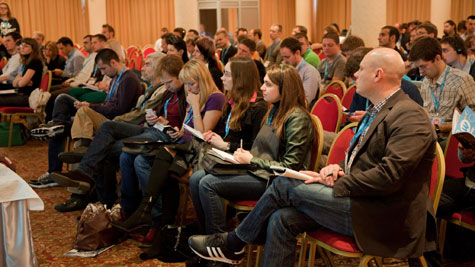Sean Clark has worn many hats during his time in the games industry. From designer to studio director and everything in between, Sean’s passion never seems to run out. He worked at Playdom, Electronic Arts, and LucasArts before settling as Director of Content Production at Big Fish Games. He enjoys everything he does in games, but what is most important to him is the fun of building entertainment experiences. “I get a rush from being a part of something coming together through a creative and collaborative effort, and I still get that rush working on great games at Big Fish,” he says. We were able to catch up with him to discuss his view on creating and producing games.
For the Love of Games
Growing up playing Pong and Atari games on the old family TV, Sean learned to love games early in life. When Atari released a Basic Programming cartridge, he immediately began learning the language and realized that programming consisted of a series of logical instructions. He discovered that building games could be an actual job.
Still, he did not plan for a career in the games industry. He graduated from Sonoma State University with a degree in Computer Science knowing he liked building things in software, especially games. LucasFilm Games (later LucasArts) happened to be hiring junior level programmers at that time. Up to this point, Sean had only created games as a hobby, but this sounded like the perfect opportunity for him. He was right: it turned out to be a great time to join the company.
All of a sudden, he was working with a group of people just as passionate about games as he was; real artists, musicians, programmers- talented professionals who could bring unique creative elements to the product. “It was a blast!” Sean says. “It was also an experience that has helped me through my whole career, right up to today as 3rd-party Director at Big Fish, working to bring fun game content to the company.” In all the roles he’s done, he’s always shown his love of games. He looks for the same passion and excitement for a game from developers, both internally and externally.
Point and Click Adventure Games Anyone?
Having been involved in multiple projects in a variety of roles, Sean has a soft spot for point-and-click adventure games. While at LucasArts, Sean helped develop The Secret of Monkey Island in 1990, a popular point-and-click adventure. It was a great experience, but problems always arise, and the solutions were often unique. Sean learned a lot about problem solving and creatively mitigating issues during this project.
However, point-and click adventure games started to slip into the background. In an interview with adventuregamers.com, Sean stated that the popularity of point-and-click adventure games would return. When we asked why he thought they had fallen to the background in the first place, his answer was emphatic. “I blame it on 3D. At the time, real-time 3D was such an amazing new capability that the faster computers and video cards enabled, it became the sexy new thing.” While 3D opened new areas of design, it also started a graphics arms race. Everyone focused on 3D graphics, with a game like The Dig being compared to Dark Force or TIE Fighter. But eventually, people realized that adventure games were a different genre to other games, like first person shooters.
He points out that in 2002, Big Fish took advantage of the 3D distraction and built a successful business recognizing and catering to the adventure gamer audience. Even Escape from Monkey Island still managed to do well in the “Adventure Games are Dead” era. Although there are not many classic 3rd person point-and-click adventure games coming to market, there is the very successful line of Hidden Puzzle Adventure Games that Big Fish is so well known for. These, Sean asserts, are a modern version of adventure game storytelling, similar to those he started his career with.
Another reason adventure games seemed to go dormant was the fact that retail space is both limited and competitive. Because attention was so focused on 3D games, it was challenging to interest retail chain buyers in adventure games. The big factor in changing the situation was the internet. Brick and mortar stores were no longer the only way to purchase games. Sean attributes Big Fish’s success largely to its creation of an online place to find and purchase great casual content, including adventure games.
Adventure Game Evolution
This new cycle of adventure games has evolved, bringing lower-priced games, which are also shorter in length, and tend to tell stories in chapters or episodes. According to Sean, these new games are still high-quality, well-polished games with great artwork, and compelling stories, although the format is different.
Sean believes Big Fish has been instrumental in bringing more attention to adventure games in a number of ways. They created a new format for adventure games, brought them to new audiences, and gave consumers a way to try the game before committing to a purchase. They figured out how to make adventure games easier to find and consume, at a time when retailers had all but abandoned support for the genre.
Sean is just as excited about the future as he is about the present. “We expect 2013 to be a year of innovation in game, content, and delivery, with games on almost every device and in nearly all casual genres,” Sean says. “In March alone, Big Fish launched 2 highly acclaimed mobile games: Fetch for the iPad, an adventure about a boy on the search for his dog; and Match Up! By Big Fish, the first iOS game to have real-time, 16-bracketed tournament play. Add to that the world’s largest interactive streaming casual game service and continuing franchises like Mystery Case Files, which has been downloaded more than 100 million times, and you can see how there is something to excite all types of gamers.”
Sean reminds us that Big Fish is an incredibly talented and creative company, with exclusive partnerships with more than 140 developers all over the world. He expects Big Fish to continue bringing fun and innovation to the games industry.











